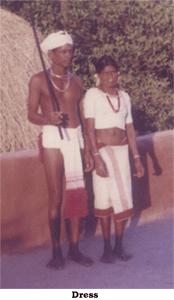|
Introduction |
|
| Economy | |
|
The Saora, variously pronounced and spelt as, Sabara, Sa-ara, Saura, Sora etc are one of the 62 tribes of Orissa. These people are mentioned in the great epics and other ancient sanskrit literatures indicating their presence since hoary past on a vast tract of land. Many other Tribal communities have added Savara as suffixs to their ethnic name for e.g. Lodha Savara, Jara Savara, in northern Orissa. Depending on their stages of socio cultural development, they are found to live in the plains and known to the non-tribal neighbours as 'Sa-ara' and Suddha Saora (purified). The community under present discussion live on the hills amidst forest in the Paralakhemundi and Gunupur areas of southern Orissa. The prefix Lanjia(tail) is given due to peculiarity of their dress. The name wear a strip of loin cloth, about six feet long and ten inches broad, around the waist, leaving a short front piece and a longer tail piece hanging. This looks like tail and hence the name. Physically these people confirm to Australoid racial type with short stature, dark brown skin colour, long head, wavy and brown hair, short, low and broad nose. Facial and body hairs are not thick. they speak a dialect of Mundari language ut can communicate in local Oriya language of the neighbours. As per 1991 census they counted 403518 which constitute 6.72% of total tribal population of Orissa, with 1030 females per 1000 males.
The Saora villages, usually small lie hidden in the forest. they build their houses on the slope or foot of the hills, using mud, stone, wood and straw thatch. Walls are plastered with red soil slip and decorated. Houses are mostly single roomed, rectangular in shape on hig plinth but low roof with front verandah. Wealthy persons build bigger houses with spacious verandah and fitted with carved doors. A Saora having more than one wife has to construct separate houses for them. At the time of constructing a new house, rice and wine are ceremonially offered to the earth goddess and pit is dug in which the first pillar is ritually fixed. The economic life of the Saoras is based on shifting cultivation (slash and burn) and terraced cultivation, as the terrain is hilly. The food deficit is supplemented by occasional hunting, forest collection. The Saoras land looks picturesque due to the terraces. The terraced fields in which water flows throughout the year are bound by stone boulders and locally called Sarroba, are exclusively meant for paddy cultivation. The upper terraces which are dry and locally called Jyanum are cultivated for millets and pulses. In the green garden around the residential areas the Saoras grow maize tobacco, chilly, some vegetables and fruits. Traditionally the shifting plots of the hills are distributed on the basis of Birinda or extended families. An individual who has been cultivating a particular plot continues to own it as long as he is capable of cultivating it. The principal food of the Saora is rice / millet gruel, vegetables, fruits and occasionally meat. Besides they take vegetables grown in kitchen gardens, and fruits, roots, leaves, tubers and honey collected from forest. No festival is observed and no guest is entertained without non vegetarian food. The smallest social unit in the Saora society is the family which is mostly of the nuclear type. Generally the family comprises parents and unmarried children. They have no exogamous totemic clan, no phatries and moieties, except the local patrilineal descent groups or lineages called Birinda. The Saora society has been divided into several sub divisions based on occupation, social status, food habits and many other customs and manners. According to Thurston's (1909) classification the Saora has been divided into two broad classes, i.e. the hill Saora and low country Saora. Under the hill Saora category the following sub-divisions are included
The low country Saora have been divided into two groups
|
Photographs by the author








